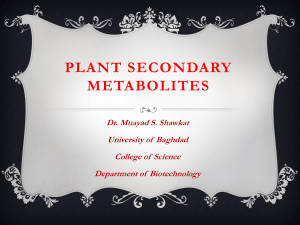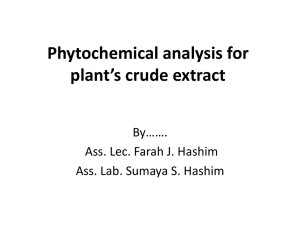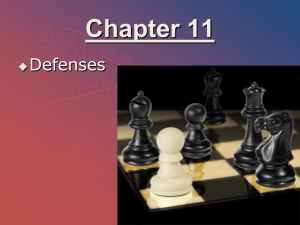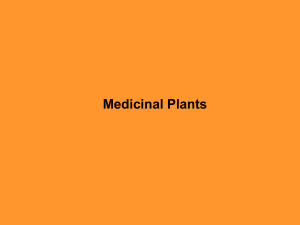Defenses
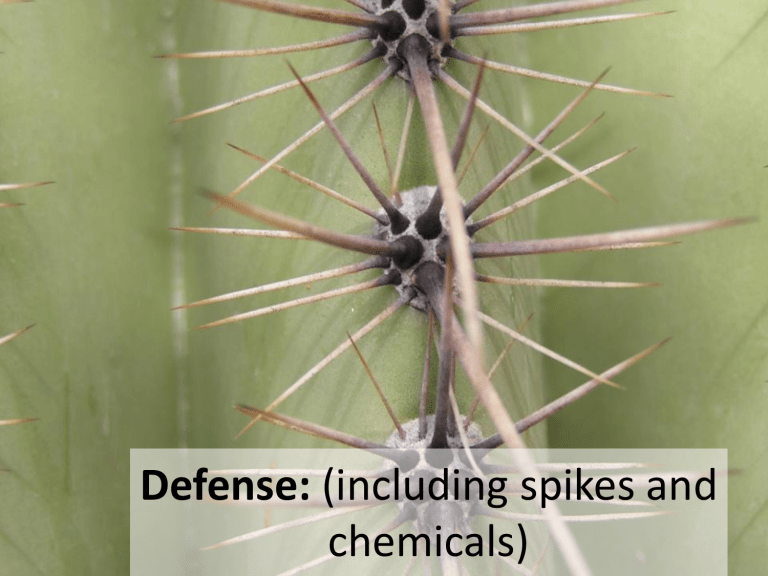
Defense: (including spikes and
chemicals)
• Any questions?
Questions
Tho' Nature, red in tooth and claw
Ferns
Gymnosperms
Angiosperms
Herbivory
• Historically who is the most important?
– Insects! Earliest forms would have been chewing leaves but diversification to sap sucking, leaf mining, gall forming, and nectar feeding.
Herbivory
• Historically who is the most important?
– Insects! Earliest forms would have been chewing leaves but diversification to sap sucking, leaf mining, gall forming, and nectar feeding.
Herbivory
• Our oldest fossils have evidence of herbivory
Defense
• Types
– Constitutive:
• Always present
• External/mechanical and large quantitative
– Induced:
• Produced after exposure to an herbivore
• Can be localized or systemic
• Secondary compounds, morphology and physiology
• Advantage?
Chemical defense
• 25,000 secondary metabolites found in plants
– Why secondary? They are not used for photosynthetic and metabolic pathways and are often byproducts.
Chemical defense
• Herbivores
– Qualitative: toxins in low concentrations (up to
10% of fresh weight)
• Not dosage dependent, causes problems with herbivore metabolic pathways
• Small, water soluble, quick to produce and cheap to transport and store
• Alkaloids, cyanogenic glycosides, non-protein amino acids, cardiac glycosides, glucosinolates, proteins
• Non-adapted specialists and generalists
Chemical defense
• Herbivores
– Quantitative: high concentrations
• Dosage dependent
• Reduce digestibility and/or palatability
– Block digestive enzymes, bind proteins being digested or disrupt protein activity in gut wall
– Tannins and lignin increase toughness
• Large, expensive and slow to produce and transport
• Phenolic compounds (phenolic acids, lignins, tannins)
• Specialists and generalists
Chemical defense
• Chemically, three main types
– Nitrogen-based: alkaloids, cyanogenic glycosides and glucosinolates
• Alkaloids (>3000): from amino acids, includes lots of good stuff (nicotine, caffeine, morphine, strychnine, quinine, ergoline). Many effects, inhibit enzymes, alter carbohydrate and fat storage, bind nucleic acids, affect cell membrane, cytoskeleton, nerves
• Cyanogenic glycosides: stored inactive in vacuoles and released when cell membranes are broken, enzymes transform to hydrogen cyanide, block respiration
• Glucosinolates: similar activation to CG
Chemical defense
• Chemically, three main types
– Terpenoids or isoprenoids (>10,000): 5-C isporene units
• Monoterpenoids: 2 isporene units, volatile essential oils
& iridoids
• Diterpenoids: 4 isoprene units, latex and resins
(Rhododendron leaves!)
• Plant steroids and sterols: vitamin D, glycosides (e.g., digitalis), saponins (lyse red blood cells)
Chemical defense
• Chemically, three main types
– Phenolics or phenols: Aromatic 6 C with a hydroxyl group (e.g., lignin, silymarin, cannabinoids)
• Tannins: hydrolizable (ellagic acid) and non hydrolizable
(proanthocyanidins)
• Flavonoids (pigmentation):
– Condensed tannins: 2-50 flavonoid groups bind plant proteins during digestion
• Polyphenols: antioxidants
Chemical defense
• Indigestible chemicals:
– Lignin, silica, stone cells (sclereids): grind down chewing parts
Other chemicals
• Also used for defense:
– Fatty acids, amino acids, peptides
– Heavy metals: iron (grasses) and aluminum
Chemical defense
• Pathogens
– Constitutive
• Accumulation of compounds (e.g., silicon, heavy metals)
• Production of antimicrobial compounds (alkaloids, flavonoids, lignin, saponins)
• Production of lipid transfer proteins effecting light and temperature
• Lectins (can hydrolize fungal cell walls) and thionins
(cysteine-rich proteins)
– Also inducible: Basal, Hypersensitive (Systemic
Acquired Resistance), RNA Silencing
Chemical defense
• Why chemical distributions are tricky
– Presence/absence versus concentration
– Spatial and temporal distribution in plant
– A given compound can break down into many others
– The same chemical can be produced by different pathways
• Furanocoumarins in Ficus, Apiaceae and Rutaceae
– And, The same pathway can produce different chemicals
Chemical defenses
• Phylogenetic associations
– Glucosinolates (Brassicales), Gums (scattered but in Fabaceae), Iridoids – C-10 (asterids and
Saxifragales) may be useful
– Ellagic acid (hydrolizable tannin) is restricted in distribution
Chemical defenses
• Phylogenetic associations
– Alkaloids and flavonoids (e.g., anthocyanins) and saponins are in lots of groups. Terepenoids found in all taxa (15,000 different types).
– Dissimilar taxa being fed on by the same or similar herbivores may be similar chemical
• Catepillars: Magoliids and Rutaceae (alkaloids),
Putranjivaceae and Brassicales (glucosinolates), and
Daphniphyllaceae and asterids (iridoids)
Mechanical defense
• Many different external deterrents
– Chemicals can be released externally: resin, lignin, silica, wax, gums
– Sharp bits
• Spines: Vascularized, modified leaf or stipule
• Prickles: Several cells thick, not vascularized
• Thorns: Modified stem, usually dead
• Trichomes: Epidermal outgrowth, e.g., hair
• Can contain irritants (e.g., urticating hairs) and poisons
– Thick protective layers
Defenses
• Other
– Thigmonasty: respond to touch
– Mimicry and crypsis: Pseudopanax in NZ, Spots that resemble insect eggs
– Leaf shedding and colour change
Defenses
• Other
– Indirect: mutualistic attraction of natural enemies
• Release of volatiles, Provision of shelters/food
– And, many secondary compounds may actually be made by endophytes and bacteria!
• Convolvulaceae, Celastraceae, Fabaceae, Poaceae
• Terpenoids and some alkaloids made in chloroplasts and mitochondria
– Some plant chemicals may be due to lateral gene transfer
– And plant parasites may take up alkaloids
Evolution of anti-herbivore defenses
Evolution of anti-herbivore defenses
Ferns
Gymnosperms
Angiosperms
Question
• Has the diversity and complexity of secondary compounds in plants intensified over time?
Question
• Has the diversity and complexity of secondary compounds in plants intensified over time?
– For 70 Bursera, measured volatile chemistry
(volatile terpenes, alkanes and aromatic compounds) and built a molecular phylogeny
Resin canals with terpenes • Main herbivore is the chrysomelid beetle Blephardia
• Coevolution for past 100 my
Question
• Has the diversity and complexity of secondary compounds in plants intensified over time?
– For 70 Bursera, measured volatile chemistry and built a molecular phylogeny
– # Compounds/species and compound diversity has increased over time. However, species diversification has been faster than chemical diversification.

